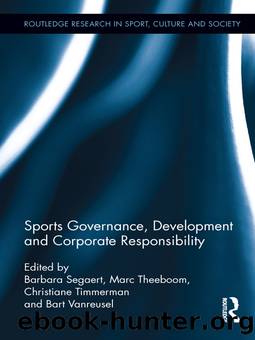Sports Governance, Development and Corporate Responsibility by Segaert Barbara;Theeboom Marc;Timmerman Christiane;Vanreusel Bart;

Author:Segaert, Barbara;Theeboom, Marc;Timmerman, Christiane;Vanreusel, Bart;
Language: eng
Format: epub
Publisher: Taylor & Francis Group
Published: 2012-08-15T00:00:00+00:00
The logic outlined in Figure 7.2 (each stage of which can be monitored and evaluated) is that the process of developing practical sporting skills (via effort and practice) may lead to the increase in a sense of self-efficacy. In addition, by operating within an ethical framework, it is assumed that participants will develop a certain degree of moral reasoning via an emphasis on sporting and ethical attitudes (e.g., respecting opponents; the need for fair play and obeying rules; collective responsibility). Within this context of the developing individual, information about health and HIV/AIDS is provided and the approach adopted, either via traditional didactic methods or via a more symbolic and integrated approach, may be significant. There may also be an assumption that those involved in sport and concerned about fitness may be more receptive to health messages and are developing an awareness that they can take some control over their fitness and health. This information is communicated within the context of an emphasis on gender equity and respect. This entails both increasing young womenâs self-confidence (often via peer leadership roles) and changing young menâs attitudes to young women, frequently by playing the same game (soccer). The issue of gender relations, power and respect are regarded by many as central to addressing the issues of HIV/AIDS, especially communicated via the role model approach of peer leadership (Kruse, 2006). These various intermediate effects may also lead to an increase in self-esteem and feelings of self-worth, although this is a much misused and misunderstood concept (see Fox, 1992; Emler, 2001; Baumeister et al., 2003; Coalter, 2007), which needs care in both measurement and interpretation.
Consequently, this hypothetical programme-theory, or theory of change, suggests that it is a combination of increased self-efficacy, the understanding of relevant information, changed gender attitudes and improved self-worth which may lead to a reduction in risky sexual behaviour, an outcome which is exceptionally difficult to measure. Nevertheless, if the programme theory is regarded as plausible and the programme is delivered consistently as theoretically intended (not an easy task in the circumstances in which many such organisations operate), then it provides a plausible basis for assuming that it has maximised the possibility of achieving the desired outcomes of safer sexual behaviour (even if this cannot be measured directly).
One thing to note about these various examples is that we have departed substantially from any simple assertions about âsportâ-for-development. Following Pawson, Greenhalgh, Harvey, and Walshe (2004: 5), we have illustrated that âinterventions are chains which are long and thickly populated-interventions carry not one, but several implicit mechanisms of actionâ.
Download
This site does not store any files on its server. We only index and link to content provided by other sites. Please contact the content providers to delete copyright contents if any and email us, we'll remove relevant links or contents immediately.
Life 3.0: Being Human in the Age of Artificial Intelligence by Tegmark Max(5193)
The Sports Rules Book by Human Kinetics(4079)
The Age of Surveillance Capitalism by Shoshana Zuboff(3991)
ACT Math For Dummies by Zegarelli Mark(3855)
Blood, Sweat, and Pixels by Jason Schreier(3498)
Unlabel: Selling You Without Selling Out by Marc Ecko(3474)
Hidden Persuasion: 33 psychological influence techniques in advertising by Marc Andrews & Matthijs van Leeuwen & Rick van Baaren(3296)
Urban Outlaw by Magnus Walker(3245)
The Pixar Touch by David A. Price(3217)
Bad Pharma by Ben Goldacre(3102)
Project Animal Farm: An Accidental Journey into the Secret World of Farming and the Truth About Our Food by Sonia Faruqi(3019)
Brotopia by Emily Chang(2899)
Kitchen confidential by Anthony Bourdain(2834)
Slugfest by Reed Tucker(2807)
The Content Trap by Bharat Anand(2781)
The Airbnb Story by Leigh Gallagher(2707)
Coffee for One by KJ Fallon(2423)
Smuggler's Cove: Exotic Cocktails, Rum, and the Cult of Tiki by Martin Cate & Rebecca Cate(2340)
Beer is proof God loves us by Charles W. Bamforth(2252)
